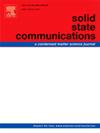Investigating storage capacity in optically active perovskite type hydrides XCaH3 (X: Na, Li and Cs) for sustainable hydrogen storage application
IF 2.1
4区 物理与天体物理
Q3 PHYSICS, CONDENSED MATTER
引用次数: 0
Abstract
The development of hydrogen storage materials is essential for advancing clean energy technologies, particularly in the context of hydrogen fuel cells and renewable energy storage systems. Perovskite hydride materials have garnered considerable interest in light of their unique crystal structure and potential for efficient hydrogen storage. This study investigates the structural, mechanical, electro-optical, and hydrogen storage properties of optically active perovskite hydrides XCaH3 (X: Na, Li, Cs) by applying first principle calculations with aiming to characterize these materials for optically mechanized hydrogen storage system. Formation energy and elastic constants verify that XCaH3 materials are thermodynamically and mechanically stable. Calculated B/G ratio and Cauchy pressure values indicate that NaCaH3 is ductile while LiCaH3 and CsCaH3 are brittle. A comparison has been made between the bulk modulus, derivatives, and lattice parameters with the existing published data. Based on the electronic properties of these compounds, they were found to be semiconductors. Analyzing the optical properties of these hydrides has demonstrated that they exhibit high absorption rates in the ultraviolet region. Furthermore, calculated gravimetric hydrogen capacity of NaCaH3, LiCaH3, and CsCaH3 is found to be 4.38 wt%, 5.7 wt%, and 1.691 wt% relative to the 4.5 wt% target set by the US Department of Energy. This is an enhanced effort to explore XCaH3 perovskite hydrides to provide a new direction to hydrogen storage systems.
研究光活性钙钛矿型氢化物XCaH3 (X: Na, Li和Cs)的储氢容量及其可持续储氢应用
储氢材料的开发对于推进清洁能源技术至关重要,特别是在氢燃料电池和可再生能源存储系统的背景下。钙钛矿氢化物材料由于其独特的晶体结构和高效储氢的潜力而引起了人们的极大兴趣。本研究通过第一性原理计算研究了光活性钙钛矿氢化物XCaH3 (X: Na, Li, Cs)的结构、力学、电光和储氢性能,旨在表征这些材料的光学机械化储氢系统。地层能和弹性常数验证了XCaH3材料的热力学和力学稳定性。计算的B/G比和柯西压力值表明,NaCaH3具有延性,而LiCaH3和CsCaH3具有脆性。将体积模量、导数和晶格参数与已有的公开数据进行了比较。根据这些化合物的电子特性,发现它们是半导体。对这些氢化物的光学性质分析表明,它们在紫外区具有较高的吸收率。此外,计算出的NaCaH3、LiCaH3和CsCaH3的重量氢容量分别为4.38 wt%、5.7% wt%和1.691 wt%,而美国能源部设定的目标是4.5 wt%。这是对XCaH3钙钛矿氢化物的进一步探索,为储氢系统提供了新的方向。
本文章由计算机程序翻译,如有差异,请以英文原文为准。
求助全文
约1分钟内获得全文
求助全文
来源期刊

Solid State Communications
物理-物理:凝聚态物理
CiteScore
3.40
自引率
4.80%
发文量
287
审稿时长
51 days
期刊介绍:
Solid State Communications is an international medium for the publication of short communications and original research articles on significant developments in condensed matter science, giving scientists immediate access to important, recently completed work. The journal publishes original experimental and theoretical research on the physical and chemical properties of solids and other condensed systems and also on their preparation. The submission of manuscripts reporting research on the basic physics of materials science and devices, as well as of state-of-the-art microstructures and nanostructures, is encouraged.
A coherent quantitative treatment emphasizing new physics is expected rather than a simple accumulation of experimental data. Consistent with these aims, the short communications should be kept concise and short, usually not longer than six printed pages. The number of figures and tables should also be kept to a minimum. Solid State Communications now also welcomes original research articles without length restrictions.
The Fast-Track section of Solid State Communications is the venue for very rapid publication of short communications on significant developments in condensed matter science. The goal is to offer the broad condensed matter community quick and immediate access to publish recently completed papers in research areas that are rapidly evolving and in which there are developments with great potential impact.
 求助内容:
求助内容: 应助结果提醒方式:
应助结果提醒方式:


